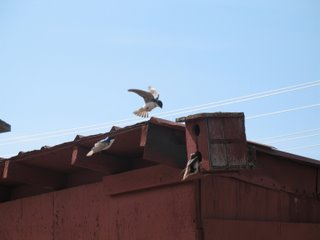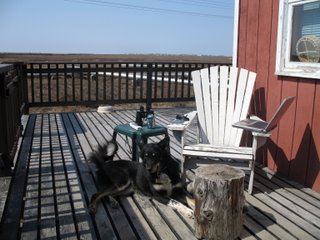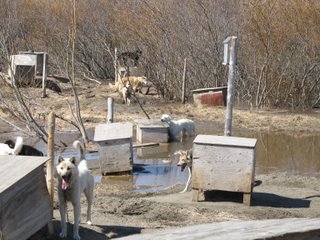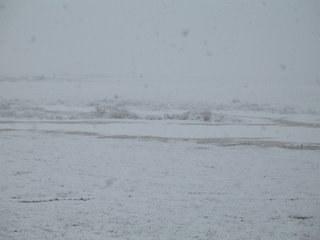The dog mushing season usually ends in early April. We have had such a delayed spring this year that the trails stayed good until early May, which is quite an extension to the normal season. But it is really over now. Last Wednesday we encountered so much water the dogs were swimming at times. Fortunately, I was wearing chest waders, but still. The dogs really hate it when it gets like that. Most sled dogs do not like water.
So to describe mushing to you, I’ll tell you about one of the winter’s earlier trips. First I must introduce you to my mushing partner, Henry. (As I stated in an earlier post, I will not use real names for people in this blog, only for places. Once I figure out how to do it, there will be a sidebar with this disclaimer as a permanent reminder.) Henry introduced me to mushing on my first visit to Alaska in the summer of 1998. He taught me everything I know about mushing, encouraged me to get my own dog team, showed me the trails and the ways of the river. He has been training dogs here for thirty years.
He is in his early 60s, and is in enviably good condition. Lean, fit, and flexible, he moves like a man twenty years younger. He has a warm nature, a friendly smile, and strong hands that know just how to scratch a dog's head. He grew up on a farm in the midwest and has worked with animals all his life.
Henry is one of the few non-Natives who lives a mostly subsistence lifestyle. In southwest Alaska, living by subsistence means that you do not have a job that provides you with a paycheck. Rather, you glean your living, and feed your family, from the land. There is a constant cycle of seasonal activities that are required in order to do that. The Eskimos have lived in this way, on this land, for thousands of years. Western culture (i.e., “modern” life, technology, book-based learning) is making deep inroads into the subsistence lifestyle. Some say that in a few more generations it will no longer be possible to live by subsistence. Hopefully that is not true.
Henry and I usually take our dog teams out together about twice a week. Our homes are about a mile apart, and my trail out intersects with his at the edge of Hangar Lake (so called for the float planes that are moored there in the summer). The lake is about a mile across, and can be terrifically windy and difficult. At times you can’t see the far edge, which is a particular challenge for the lead dogs. One of the more difficult tasks for a leader is to be able to maintain a straight line of travel when there are no landmarks and the wind is blowing sideways.
For much of the winter, the goal of our mushing trips is the ice fishing net. There is good fishing in the winter for pike, whitefish, and lush fish. Henry usually keeps a set net under the ice on the Kuskokwim or one of the smaller tributary rivers. The net must be hauled out and the fish removed every two to three days. It makes for a nice afternoon to hook up the teams, run the ten miles or so out to the net, gather the fish, and run back home. I’ll take you on just such a trip from late winter.
It is mid-February, and though the days have started getting longer, two months past the winter solstice we are only up to about eight hours of daylight. Much of the last six weeks has been extremely cold—twenty to forty degrees below zero. Henry took his net out shortly after the hard cold started; it is just too difficult to deal with pulling fish from the water at those temperatures. The net, the fish, and your hands freeze almost instantly on exposure. At forty below, your spit will freeze before it hits the ground.
Henry had put his net back in two days earlier, so we are heading out to check it for the first time. He is hopeful that this new spot up on the Tubungaluk River will be a good one. It is a sunny morning right at zero degrees, which feels amazingly balmy after weeks of twenty below. Part of the get-ready includes packing a lunch of sandwiches and a thermos of coffee, and a bag of frozen fish chunks for the dogs. And a bag of extra clothes, including boots, in case you get wet. Tools for chipping holes in the ice, rope for threading the net under the ice, and big burlap bags for (hopefully) bringing home lots of fish.
This is perfect weather for the dogs. Zero is ideal temperature for them, and the two inches of snow that fell yesterday will soften the snowmachine ruts in the trail, as well as give them easy bites of snow for hydration while they are running (“dipping”). As I start loading gear in the sled and laying out their harnesses, they are wildly excited, barking, jumping on and off their houses, running in circles around their posts. They truly love their work, and every dog wants to go. Since we have fairly deep snow right now, I need all nine to pull the sled; fortunately there are no females in heat at the moment, and no muscle strains or sore feet. Everybody gets to go today.
The sled is packed and the ice hook is firmly planted to anchor it. The gangline is stretched out in front, and dogs will be hooked to it in pairs; first the leader(s), then the swing dogs—collectively known as the “front end”—then the team dogs. The last pair, just in front of the sled, are the wheel dogs. Wheel is a difficult position, as those two dogs get jerked by the sled more than their teammates do.
I harness Lucky first and attach him to the gangline in lead. He is a big white-blond male with a very fast trotting gate; he responds well to gee/haw commands (“right” and “left”, respectively), and he pulls hard. His job for the rest of hook-up is to hold the line out taut while the rest of the team is harnessed and attached. He is less good at this than I would like, so a second ice hook is attached to his harness and placed in front of him to keep him from wandering.
In swing position are Lucky’s brothers, Flash and Woody. Flash is red-blond, Woody looks almost exactly like a timber wolf; both are secondary leaders, and the three together make quite a strong front end.
The first team pair behind swing are Balto and Blue. Both are almost solid black, with little brown eyebrow spots and white crosses on their chests. Blue is named for her piercingly ice-blue eyes. Balto is named for one of the most famous sled dogs of all time, a leader of the team that took diphtheria serum to Nome during the epidemic in the 1920s, saving the lives of countless children. There is a statue of the original Balto in New York City (of all places).
Next in line are Buster and Brownie. Buster looks much like Balto. He is the weakest link in the team; he is just not strong-minded, which is an essential quality in a sled dog. I keep debating whether or not to keep him. Brownie has a special place in my heart, as she is the mother of my house dog, Bear. When Brownie arrived, she was pregnant, though neither I nor the Yukon musher I bought her from knew it at the time. I came home from a two week vacation in the Lower 48 to discover a single, HUGE puppy, just opening his eyes. He became the dog yard mascot, running in and out of all the dogs’ houses, eating from their bowls, and tolerated by all his bemused aunts and uncles. When he got too big to fit in Brownie’s house with her, he moved inside with me. I’ve often wondered what kind of dog fathered Bear; he is huge, much bigger than Brownie, and weighs about 70 pounds—all lean muscle and long legs.
The pair in wheel today are Sasha and Yoda. Sasha is the mother of the whole team, and is an old leader. She is a solid white dog who never goes in her house. Ever. Doesn’t matter how cold or windy it is, she will sleep on the ground curled into a tight ball with her tail over her nose. Her circle has several saucer-like depressions where her body heat has melted the ice under her as she slept. She pulls hard and never gives up. Last year she had a hysterectomy due to pyometritis following a heat cycle. I had no idea anything was wrong, she just seemed to be off her food and moving a little stiffly. I thought she had just over done it on a hard run two days earlier. But the vet happened to be in town for his monthly visit, so I took her in. Her uterus was so full of pus, he said she would have died within the next 48 hours. The infection had been building since her heat cycle ended the week before.
Yoda is a mostly-black dog, so named for her serene disposition. When the other dogs are jumping and barking, she is sitting quietly and watching. She pulls hard, but she doesn’t have a fast gait. Her strong, stocky build makes her a good wheel dog, and she and Sasha work well together.
I pull the hook at 10 a.m., about an hour after sunrise, as Henry and I agreed on. If he is on schedule also, we should get to our meeting spot within five minutes of each other. The team leaves the yard like they were shot from a cannon. Fortunately my trail out is basically straight and flat, which minimizes disasters. I’m riding the brake the whole way (a length of snowmachine track with studs, mounted to the underside of the sled, which I can step on between the sled runners), controlling their exuberance reasonably well. After a mile or two they settle into their rhythm.
I love to watch the team working. Stretched out in front of me, they move together smoothly, many legs of a single unit. Heads down, pulling hard, tug lines taut. They know this trail well, and Lucky needs no directions.
We reach the meeting place only a moment before Henry, who doesn’t stop. My team falls in behind his and we cross the snow-blown surface of Hangar Lake with a blessed lack of wind. The trail follows several frozen sloughs, passes through stands of willow and cottonwood, and then heads up to high tundra on a bluff above the Kuskokwim River. This is one of the highest natural elevations in the area, perhaps a hundred feet above the river, and the view is magnificent. The land curves away to the horizon in all directions. It feels like the top of the world. It is also pretty windy up here, so we quickly move on.
While we are traveling, Henry wants to practice some passing exercises, so at random intervals the musher in back will yell “trail!” The musher in front will command the team off to the side, put the ice hook in and go up to stand by the lead dog, allowing the team behind to pass. This is race etiquette, as a team is required to “give trail” when being overtaken by a faster-moving team; it is also good practice for the dogs. They must learn to pay no attention to other dogs when passing or being passed by another team.
We make good time, and get to the net in under an hour. The dogs are ready for a little break, and they are used to this routine, so they all lie down quietly to wait.
A pair of sticks marks each end of the fish net, about 50 feet apart. The sticks are frozen into the ice, and look like they are growing out of it. We each take an ice chisel on a long handle and begin chip-chip-chipping a hole next to each pair of sticks. The holes must be about two feet across and have straight sides down to unfrozen water. I am working on the hole closest to the shore, and hit water after about 18 inches of ice chipping. Henry is on the deep-water end of the net and breaks through at 30 inches. He is a lot faster at it than I am, so we hit water about the same time. River water comes bubbling up cold and clear.
The net is stretched underneath the ice and attached to one of the sticks at each end; the other stick serves as a tie-off for the net stick. We free one net stick, untie it from the net, and tie a long rope to the net in its place. Back to the other side; we free the net stick from the ice and begin hauling the net up through the hole.
Right away we’ve got fish! Henry is excited; looks like his intuition was right on the money about this location. We free the fish from the net as we pull it up, tossing them wiggling and flopping on the ice off to the side of the hole. Every two or three pulls yields a few more fish, and—oh joy! They are almost all the most prized fish of winter, whitefish!
By the time the net is completely out of the water we have landed 29 fish; only a few are lush, and there are no pike at all. Two dozen whitefish is a truly great catch!
The long rope we tied to the free end of the net is now hauled back out, pulling the net back across under the ice. Henry does the pulling and I feed the net carefully into the river through the hole, then tie the net stick to the anchor stick. On the other end, Henry ties the free end of the net to his net stick and the net stick to the anchor stick; then we cover the holes with squares of plywood he brought along for the purpose and weight them with snow and ice chips. The covers will keep the ice from freezing in quite as thickly, making it easier to chip the holes out next time.
We gather fish into the burlap bags, load them in the sleds, and take a break to drink coffee and eat our sandwiches. The dogs know that snack time is coming for them too, and they remain quietly watchful.
The Tubungaluk is a small river compared to the Kuskokwim, less than half a mile across at our fishing site. We are maybe two miles upriver from where it empties into the Kusko. A tall stand of cottonwood (tall = 20 feet around here) lining the near bank breaks any wind, and a deeply blue sky arches over us. The sun is bright, and looks like it should be hot, but there is hardly any strength to it yet. Though it is noon, the sun shines on us from about 45 degrees above the horizon.
After lunch, we lounge on our sleds and rest. One of the things I enjoy about Henry is that we can spend extended periods in comfortable silence. I love lying on my back on the sled and gazing up at the sky; it is a perfect blue bowl, from horizon to horizon. We are quite a way from the main snowmachine trail between Akiachuk and Bethel. We are completely alone in a huge wilderness, and lying there looking at the sky, I become aware of the deeply profound silence. The dogs are still, the wind is still, Henry and I are still. No planes pass overhead, no snowmachines whine in the distance. There is no sound whatsoever. None. I strain my ears to catch even the slightest noise of any kind, but nothing breaks the stillness. Minutes go by, and I marvel at the luxury of total silence. It is something that hearing people do not often experience.
After a bit it is time to get moving. Even at a balmy, windless zero degrees, you start to get cold if you stay still for too long. The dogs are looking alert, as this is their cue that it is snack time. Each dog gets a thumb-joint sized piece of frozen fish, which they swallow in a gulp. We pack all the gear back in the sleds, lash it down, and pull the hooks. The dogs know we are headed home, and their pace is lively and energetic without being wild and frantic. We move along nicely at about 12 miles per hour. The only sounds now are the dogs’ panting breath, the chut-chut-chut of their feet on the snow, and the shooosh-shooosh of the sled runners. I stand on the runners, controlling the sled as it slides around corners, slowing it on the descents so it doesn’t bump the wheel dogs in the rump, pushing it up the inclines when the dogs need some help. Lucky has an amazing ability to retrace his steps, but I catch him glancing back at me occasionally, as if to say, “yeah, Boss, this way, huh?” I love him. He is a great dog, and a good leader.
Henry and I part with a wave at our usual spot and Lucky takes us home without any problem. As we pull into the yard, I “whoa” the dogs and plant the hook. They all stand quietly, in contrast to the chaos of leaving the yard. First I place a piece of meat on top of each dog’s house, then unharness and release one dog at a time. Each one races to his or her own house, gulps down the treat, and waits for me to reattach the chain. It always amazes me that the first dog doesn’t race around and grab all the treats, but they don’t. Each dog gets praise, head-rubs, and thanks. The lead dog is always first on the gangline and last off, and Lucky gets extra petting and thanks for his job well done. He leans against my legs, and licks my face when I bend down to rub his big head.
The fish and rice stew I cooked for them yesterday is only partially frozen, and it warms up quickly on the propane cooker. I do “poop rounds” while it is heating, and then serve each dog a ladle full with some extra kibble. While they eat, I hang harnesses in the shed to dry, unpack the sled and put fish in the freezer. As I head inside for a nice hot shower, Balto starts a soft low howl. He is the yard’s songleader. The other join in one by one, some standing on their houses, some lying inside with head out the door, some sitting on the ground; all have their noses pointed up, crooning a beautiful owwwwwoooooooooo-ow-ow-ow-owwwwwooooooo… Each dog’s voice is distinct, and together they have a beautiful harmony. The song goes on for about a minute, then slowly dies away. The haunting echoes linger at the edges of the dog yard, and then all is quiet. It is the most eloquent statement of contentment and happiness.
Labels: Dog Mushing
















